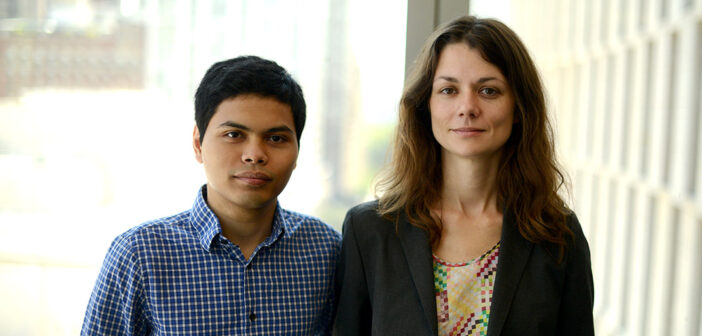
Fordham Law student Rodrigo Ricxu Bacus and NYUICP director Olga Byrne are volunteering their time to help parents of immigrant children displaced by the violence plaguing Central America.
Photo by Patrick Verel
As a volunteer helping anxious parents understand the immigration system and fight to keep their children in the United States, Rodrigo Ricxu Bacus, found that parents sometimes needed more than just information. They needed encouragement, reassurance, and hope.
“It’s a confusing system,” said Ricxu Bacus, one of a handful of Fordham Law students who volunteered to assist at information sessions sponsored by Catholic Charities in Manhattan. “I sometimes [found]myself saying, ‘This is just the process. It’s not a barrier.’ I guess it can be, but I try to reassure them: just think about the process, what you need to do, what your responsibilities are.”
Student volunteering is just one effort at Fordham to grapple with the current immigration crisis, marked by tens of thousands of vulnerable Central American children fleeing violence in their home countries for the United States, where they often seek to reunite with family.
This year 90,000 children are expected to be apprehended at the southern U.S. border, up from 7,000 or 8,000 annually just two years ago, when the numbers started to spike, said Olga Byrne, director of the New York Unaccompanied Immigrant Children Project (NYUICP) at the Feerick Center for Social Justice of Fordham Law School.
The majority of the children are trying to reach parents or relatives here, Byrne said.
“There are so many stories of family separation and reunification behind this,” she said. “It could be parents who have been living here for a decade and left behind a toddler in their home country who’s now a teenager. Parents are desperate to see their child, like any parent would be. On top of that, the kid is getting menaced by gangs who may either want to kidnap him (or) extort him—‘Oh, you have parents in the U.S.? We’re really going to go after you now because you are getting remittances sent back.’”
The NYUICP—a collaboration among the Feerick Center and other external organizations—involves research and advocacy efforts to make it easier for unaccompanied immigrant children to make their case for legal residency. (The children are given court dates after being apprehended at the border and, where possible, released to any relatives in the United States.)
Thousands of other undocumented young immigrants in the New York area are entirely alone, without support from family, and are vulnerable to exploitation by traffickers, smugglers, employers, and others, according to the Feerick Center.
The center and Fordham’s Institute of International Humanitarian Affairs (IIHA) cosponsored a panel in June on the migration crisis, and IIHA Director Brendan Cahill intends to host more—perhaps one per semester—that will point to solutions.
“By everyone’s account, this is a humanitarian crisis,” driven by gangs who are preying on the young in Honduras, Guatemala and El Salvador, he said. “Parents are saying, ‘Take a bag and go. Get to a safer place.’”
Another Fordham event focused on the immigration crisis will take place Sept. 16, when the Center on Religion and Culture and the Center for Ethics Education cosponsor a panel discussion, “A Crisis of Conscience: What Do We Owe Immigrant Youth and Families?”
Meanwhile, Fordham law students who volunteered at Catholic Charities last year will renew their efforts this year, and hope to recruit more of their peers.
They’re helping out at a Catholic Charities legal orientation program that informs the children’s custodians about bringing the children to immigration court, helping them sign up for school, obtaining health care and other services, and protecting them from trafficking and other dangers.
While the students can’t offer legal advice, they can answer questions not addressed in the one-hour presentation, help attendees fill out forms, and provide general information and referrals.
Some are finding that school systems won’t accept the children as they’re supposed to, said Laura Wooley, a law student and the coordinator of the volunteer effort. Others might struggle with forms that aren’t available in Spanish, said Ricxu Bacus, once a child immigrant himself.
Born in the Philippines, he had to wait 10 years to join his mother in the United States after she moved here on a green card. He remembers the fear and confusion he felt as an adolescent going through the slow, bureaucratic intake.
“When you’re looking at a maze of things, at a process where you have to do 20 different steps, it’s much easier to see an obstacle than it is to see a pathway,” he said.



